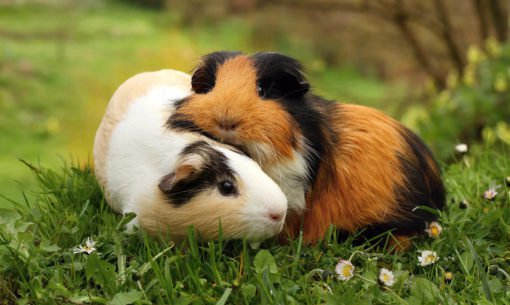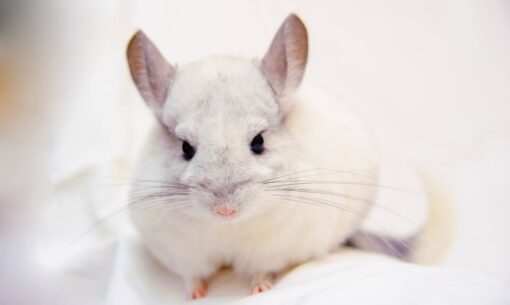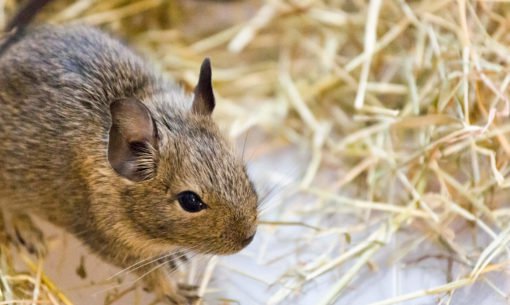Rabbit FAQs
Keen to find out more about bunnies and how to look after them? Discover the answers to some common questions about these adorable creatures.
Are rabbits good pets?
Rabbits make lovely pets for caring owners. Although they have long had a reputation as being pets suitable for children, most people now believe they are more suitable for adults or older children, owing to their specific needs.
Some of the rewarding behaviours that rabbits can show, including being responsive to the presence of their owners and showing joy – the jumps that happy rabbits make are called binkies. Rabbits also play, burrow and make nests with their bedding material. Their coats are soft to the touch and in the main, they are very gentle pets when correctly handled. Rabbits should always be kept in pairs as the companionship of their own species is very important to them.
Although rabbits don’t need to be taken for walks, their hutches need cleaning daily and they need access to an area that’s large enough for them to take exercise. Many standard hutches are now considered to be too small for most rabbits and some people now tend to opt for small garden sheds or indoor pens and rooms, so that their pet has enough space to express natural behaviour. In some countries, keeping rabbits indoors is likely to be much safer than keeping them outside.
Rabbits are prey animals and therefore can be easily startled or frightened by inexperienced handling. A rabbit that is being held, but not well restrained, can damage their backs, even causing spinal fractures which are often fatal. Fearful rabbits may freeze and this is sometimes mistaken for a positive reaction. For instance, if a rabbit is laid on its back, many people believe that the trance-like state reflects complete trust and relaxation – in fact, this is a highly stressful experience for the rabbit. Their strong back legs mean rabbits should only be handled by people who are strong enough to hold them correctly if they kick out – this is one of the reasons they are not ideal pets for very young children.
Many people who own rabbits also own other types of pets too and love their rabbits just as much as they love their cats or dogs.
Are rabbits rodents?
The short answer is no – rabbits are not rodents. Rabbits are lagomorphs, although in the past they were wrongly classified as rodents. Unlike rodents, lagomorphs are herbivorous and should only be fed a plant-based diet. In fact, some researchers have suggested that rabbits have more in common with animals such as cattle or sheep, than with rodents.
Many rodents eat meat as well as plants and their bodies are adapted to allow them to digest the different food stuffs. Rabbits have a single stomach and a well-developed hind gut to allow them to break down plant material. Another feature is that rabbits eat their droppings – this is called coprophagy. The process allows them to extract more nutrients from their food.
Although both rodents and lagomorphs have continuously growing teeth, lagomorphs such as the rabbit have an extra pair of peg teeth behind their front incisors (the large front teeth). The lower incisors rest against these peg teeth.
As rabbit teeth grow continuously, it is really important that they have the opportunity to chew to wear the teeth down and prevent overgrowth or uneven growth. This continuous growth is a feature they share with rodents. One of the best ways to ensure that rabbits can keep their teeth healthy is to provide plenty of hay to chew. When choosing foods for your rabbit, always opt for one that contains plenty of fibre and always offer fresh hay and water alongside any other foods.
Are there vaccines for rabbits?
Depending on the country you live in, vaccinations may be recommended for your rabbit. In the UK, the vaccinations that may be recommended by your vet include vaccines against myxomatosis and two strains of rabbit viral haemorrhagic disease (RVHD and RVHD2). The vaccines can be given from around 5 weeks of age and immunity lasts about a year, when the vaccine should be repeated.
Pet rabbits can become infected with myxomatosis if they have contact with an infected rabbit or through parasites that feed on their blood and transmit the disease (this can include fleas and mosquitoes). Even indoor rabbits can become infected with myxomatosis because of the risk of infection from parasites.
RVHD is an especially distressing disease-causing bleeding and sometimes sudden death. As well as contact with an infected rabbit, it can also be spread by biting insects and also virus on objects such as clothing or shoes (called fomite transmission). There are two strains so the vaccine given needs to protect against both.
Always check with your vet about the vaccines they recommend for your rabbit depending on the risk in your area.
Do rabbits eat carrots?
While rabbits do eat carrots and enjoy them, it is best to avoid giving too much. This is because carrots contain higher sugar levels than other vegetables and this can be detrimental to dental health. Sugary foods can also upset a rabbit’s digestive system, causing loose motions that become stuck around the back end. If this happens then the rabbit may also become prone to fly strike, which can be a serious condition requiring urgent veterinary care. One benefit of carrots is that they offer opportunities to chew and this is an essential activity for rabbits because of their constantly growing teeth. Hay is a better substrate for chewing as it provides long fibre and promotes digestive health. Fruit tree branches are also ideal for chewing and preferable to giving carrots.
Do rabbits need baths?
Rabbits should not be bathed unless in highly specific situations as recommended by a vet. Rabbits usually keep their coats clean through grooming and the natural oils provide sheen and help repel dirt. Bathing a rabbit is not without risk because they can become frightened and slip or kick. Injuries as a result of this can include breaking their backs. Rabbits can also be easily chilled if wet and their coat can take a long time to dry, often clumping together. Rabbit skin is also very fragile and can easily be torn.
If a rabbit suffers from flystrike, a vet may carefully clip away soiled hair and clean the area. If a rabbit has a medical condition (such as joint disease), mobility problems or soiling around the back end, it may be necessary to spot clean that area to avoid flystrike from occurring. Your vet can identify and potentially treat an underlying problem to reduce the stress frequently cleaning might cause.
Grooming both short and long-haired rabbits regularly is a good idea to keep the coat in good condition, to build a bond with the pet and also so that they can be regularly checked for injuries or disease.
What rabbits make the best pets?
Although many people believe that some breeds of rabbit make better pets than others, it’s mostly true that happy rabbits make the best pets. A happy rabbit will feel secure and able to express its natural behaviour. And that means that their owners tend to have more positive experiences of pet ownership. Make sure you understand about how best to meet your rabbit’s needs for housing, food, company and exercise.
While larger breeds of rabbit are often more placid, not everyone wants a quiet or sedentary pet. Some people prefer breeds that are active but may need to adjust to their higher levels of alertness which can cause them to be more easily startled. The look of a particular breed may also appeal more and the more appealing you find a pet, the more likely you are to put time and money into caring for his or her wellbeing.
Remember too that a large rabbit requires much more space and therefore you should consider how big their accommodation needs to be so that they can rise up on their hind legs and hop around. That means 4-5 foot in height and around 12 foot long – so around the size of a whole room!
Some people prefer to own a male rabbit – as they tend to be more relaxed about being handled and are less likely to burrow. A female rabbit is a little more likely to guard her territory and may need more considerate handling as a result. If keeping rabbit pairs (and indeed they should all have a rabbit companion), it is also less expensive to have a male rabbit neutered than a female rabbit.
Young rabbits can be more easily accustomed to gentle handling over time. An adult pet that is being re-homed may already be friendly, tame and confident around people. Think about how much time you can give to this process when choosing your pet. A rabbit can live for 8 to 12 years and the life of a human can also change a lot in that time, so you want to consider whether a younger or older rabbit might be more suited to your circumstances.
When do rabbits sleep?
As prey animals, rabbits often sleep quite lightly although they also have periods of deeper sleep through the day or night. Being with other rabbits might help them sleep more deeply as the other rabbits act as a warning to threats. Rabbits are most likely to be lively at dawn and dusk (which means they are crepuscular). The low light conditions at this time probably help them to feel safer. In all rabbits probably ‘sleep’ for around 11 hours in a 24 hour period. Around a quarter of this time is spent in general drowsiness, around two thirds is deep sleep and the rest is light sleep. Rabbits can sleep with their eyes open or closed and may sleep sitting up or lying down. This means it can be difficult to tell if they are actually asleep, dosing or awake. Their alertness means that it can be difficult to catch them napping!
Should rabbits be kept in pairs?
Yes! Rabbits are best kept in pairs or even in small groups. They will groom each other, feed together and sleep together. Being with other rabbits provides them with companionship and also security – with more rabbits available to be on the look out for threats. Neutering rabbits ensures opposite sex pairs do not breed and once neutered, a male and female rabbit is often a good combination. Rabbits paired when young also tend to be more compatible long term. It is quite traumatic for a rabbit to be separated from another rabbit it has bonded with. Being within sight, sound and scent or another rabbit can also be very comforting for rabbits, so new introductions can be made gradually with rabbits side by side. Pairing is often easier in winter but can be carried out at any time of year and a single rabbit should not be left alone for any significant period of time.
Should I give my rabbit vitamins?
If a healthy rabbit is provided with a daily portion of food from the Supreme Science Selective and Tiny Friends Farm ranges (alongside unlimited fresh hay, a handful of leafy green veggies and water), they are unlikely to need any additional vitamin supplements. Good quality rabbit foods – usually kibbles or mix – will contain added vitamins and minerals to balance out the nutrients already provided by the other ingredients. An exception might be indoor rabbits with insufficient exposure to sunlight, which is needed to make vitamin D, or rabbits kept in hutches without enough daylight. These rabbits may be deficient in Vitamin D and need a supplement. Rabbits that are fed an unbalanced diet, with insufficient hay may also be deficient in a number of nutrients. Unlike guinea pigs, rabbits do not have to be provided with Vitamin C in their diet, as they can make this in their bodies from other nutrients.
Do rabbits need to chew wood?
It’s certainly true that rabbits need to chew but that need not be wood. In fact, it’s most important that rabbits chew on hay and/or fresh grass every day – preferably an amount as large as their whole body. As well as the mechanical benefits of chewing to wear down a rabbit’s constantly growing teeth, hay also provides long fibre which helps keep their digestive system healthy. If offering wood for your rabbit to chew, fruit tree branches make a good choice.
Is it OK to keep rabbits indoors?
Depending on the risks outdoors, it is sometimes preferable for rabbits to be kept indoors in some areas. Potential risks include extremes of weather – either too hot, too cold or too wet, the threat from predators and disease risk. Regardless of where a rabbit is housed, their basic welfare needs must be met. This includes giving them enough space to exercise and express natural behaviours such as burrowing and foraging. Indoors this can be achieved by providing a substrate to dig and toys to play with. There should be places to hide and rest and food can be placed in different locations to be foraged. Many people feel that keeping their pet indoors allows them closer proximity to their pet, helps them form a closer bond and enables them to provide higher standards of care as a result.
How much to feed rabbit daily?
Rabbits love to graze and spend much of their time eating. However, it is possible to overfeed a rabbit and weight gain, obesity and associated ill health can be the result. If you need to know how much to feed your rabbit, here are some suggestions about how much to give:
- Provide good quality hay daily; an amount about the same volume as your rabbit’s body size is about right.
- Give a small handful of fresh, washed greens.
- Provide kibble or mix according to the feeding instructions on the pack. There is just a guide, so you may need to adjust the quantities up or down, depending on how active your pet is and their body condition. Be careful to avoid feeding food containing sugar (including hidden sugars like molasses) as the sweet taste can cause overeating and also have a detrimental effect on digestive and dental health. We recommend around 60-70 grammes daily.
- Always provide unlimited, fresh drinking water.
How can you tell if your rabbits has fleas?
In light coated or white rabbits, it is relatively easy to spot fleas – they are 1-2mm long, black in colour and fast moving. Fleas don’t spend a lot of time on the rabbit though so even if your rabbit is suffering with fleas, you might not always see a live flea – especially if your pet has a dark coat. Flea dirt is easier to spot – this looks like small dark granules, which, when placed on wet, white kitchen towel appears reddish brown (since flea dirt contains dried blood). Hair loss and scratching can indicate your rabbit has fleas but sometimes no signs are seen until the flea infestation is quite serious. Regularly grooming your rabbit gives you a great opportunity to check for parasites such as fleas. Always use a flea treatment that is suitable for rabbits – your vet can provide you with advice about treatment and future prevention.
Interested in more pet frequently asked questions?
Try our tasty pet foods today!
Pets devour over 200 million portions of our pet food and treats every year. If your pet hasn’t tried our food yet, you can find out more about our irresistibly tasty small pet food and treats here.



